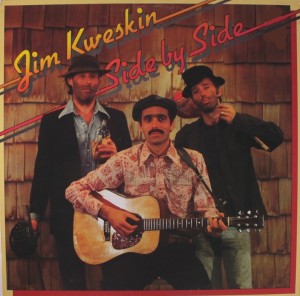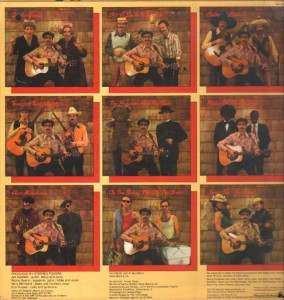The beauty of listening to old school Americana, folk, Tin Pan Alley or the Great American songbook music is you don't have to worry about authorship.
Whether the artist wrote or didn't write the songs is second to the message and mood being conveyed.
A lot of the music comes from a time when music was a form of, err communication. Well, I suppose, it still is but way back when it was literally a form of communication … a way of telling people what was going on in the world (folk), expressing emotions (trad pop), showing a feeling (ragtime), or capturing a past (cowboy songs).
As a result, up till World War Two, song writing was more than a beat and a few snappy lines. The inherent communicative aspect of the songs made them especially evocative of their times and much more central to that community as a form of communication and entertainment. There have been many pop songs since that can be dusted off and sung aging and that is a benefit, perhaps. But these pre-war tunes, despite being revived (especially in the late 50s and early 60s by rock and pop singers) are more locked in the times when they were written.
That's not to say these songs are dated. They aren't. The music is not any less worthwhile because, despite technology, the problems and emotions people sing about then still relate to now.
Right?
Well, if that isn't right we wouldn't be reading (or rather watching) Shakespeare or Tennessee Williams.
So what does it mean when a guy in 1979 (or even now) puts out an album like this where most of the songs are from (or sound like they are from) another era?
It means the music is alive
Marginalised perhaps.
But alive.
And it is literally alive here, or rather live. This was recorded live at McCabe's, Santa Monica, California. And judging from the audience (and the thought to the song selection) the subjects of the pre-war songs was still relevant in 1979 and I would think they still are now.
You can listen to these tunes and they will still move you as any more recent music. Sure, if you haven't turned your ear to the music itself, you may have to try an little harder to acclimatise yourself to the music, but the emotional payoffs should be the same.
Also, to me, brought up on watching old black & white movies on Saturdays and Sundays on TV in the 70s and 80s, this music is a link to that past. I suppose, it is also a link further back to a past which I never knew (pre World War 2) which I understand through the prism of Hollywood films I watched.
Kweskin is an aficionado of all this music. Check my other comments for biographical details.
This is all second nature to him and he was in the right place and time.
The early to mid 70s saw a resurgence in this old-timey Americana from the 20s and 30s. Kweskin was active, as was Redbone and The Manhattan Transfer (slick vocal pop). "The Great Gatsby" (1974), "The Sting" (1973), "Nikelodeon" (1976), "Julia" (1977), "Bound for Glory" about Wody Guthrie, and any number of gangster pics all looked back to that era with suitable music in place. "Ragtime" (1975) by E. L. Doctorow, "The Gang That Couldn't Shoot Straight" (1970) by Jimmy Breslin, "The Other" (1971) by Thomas Tryon, and other books were set in that era.
Kweskin just kept doing what he was doing.
He has made some concessions though. Kweskin was always quirky though not adverse to doing a song straight no matter how sentimental or sticky it may be. Here, his set is more straight than quirky, and he does not really explore his quirky side (with the exception of the song choices themselves).
He is in good voice and the small band behind him know exactly where his coming from , and going.
As an aside I note that Kweskin was, pretty much, always moustached. And it is fitting, here, that he is moustached given the hairy lip was in fashion in the 1970s as well as the 1920s and 1930s. Having said that Kweskin doesn't look like Burt Reynolds, Robert Redford, Errol Flynn or Clark Gable but rather like a migrant off a boat, Ellis Island circa 1929.
Perfect.
With the recent resurgence in Americana and old-timey music I hope that Kweskin has more bums on seats at his concerts. He is playing out there somewhere. Pokey La Farge and others are carrying the banner but I hope there is room for Kweskin.
Tracks (best in italics)
A lot of discographies have the sides the wrong way around. Kweskin labels his record "left side" and "right side" rather than "side one" and "side two". But he is clearly being introduced at the start of "Goody Goody" which is the first song on the "Left side" which is also sometimes listed as "side one". The back sleeve has no discernable order to the songs.
- Goody Goody – (Matty Malneck / Johnny Mercer) – another trad pop classic, from 1936, covered by everyone and with a hit pop rock version by Frankie Lymon (1957). http://en.wikipedia.org/wiki/Goody_Goody
- Side by Side – (Harry Woods) – from 1927 this has become a standard with many covers. Kay Starr (1953), Dean Martin (1966), Trini Lopez (1965), Bruce Willis and Danny Aiello (for the Hudson Hawk movie soundtrack in 1991), Guy Mitchell (1952). http://en.wikipedia.org/wiki/Side_by_Side_(1927_song)
- It's a Sin to Tell a Lie – (Billy Mayhew) – from 1936 this (beautiful song) was originally by Fats Waller (or maybe Freddy Ellis) and then done everywhere including a informal version by Elvis in 1966 which is based the Ink Spots version (1956 I think). Kweskin does it beautifully and gets the audience to participate.. http://en.wikipedia.org/wiki/It%27s_a_Sin_to_Tell_a_Lie
- Cieleto Lindo – (Public Domain / Carlos Fernandez / Traditional) – an old Mexican song dating back to the 19th century but forever being revived. Kweskin doesn't sound remotely Latin (despite singing in Spanish) but I have always loved this song (even the Croatian version (!) I heard as a kid) http://en.wikipedia.org/wiki/Cielito_Lindo
- Tumbling Tumbleweeds – (Bob Nolan) – Done by everyone, always associated with the authors Sons of the Pioneers (1946), it was also done by Gene Autry (1935), Bing Crosby (1940), Slim Whitman (1956), Michael Nesmith (1970), Don Everly (1970) and the Meat Puppets (1982). Every version of this song is good and this one is no exception. http://en.wikipedia.org/wiki/Tumbling_Tumbleweeds
- The Preacher and the Bear – (Joe Arzonia / Jim Kweskin) – Rustic and rural ("Grizzly Adams" was popular at the time) but obviously allegorical. A traditional done by everybody including Golden Gate Quartet (1937), New Christy Minstrels (1962), and Jerry Reed (1971)
- Papa's on the Housetop – (Leroy Carr) – a blues dating back to 1930. This is a gentle stomp.
- On the Sunny Side of the Street – (Dorothy Fields / Jimmy McHugh) – done by everyone (I mean everyone) this is a beautifully optimistic song (which is also often used as irony) with some of the most sublime lyric written. And who doesn't know that melody? http://en.wikipedia.org/wiki/On_the_Sunny_Side_of_the_Street
- Ain't Misbehavin' – (Harry Brooks / Andy Razaf / Fats Waller) – the legendary old school, trad jazz song, originally from 1929. Kweskin does the long instrumental intro like on the pre-war versions of the song. http://en.wikipedia.org/wiki/Ain%27t_Misbehavin%27_(song)
- Sweet Sue, Just You – (Will J. Harris / Victor Young) – Originally from 1928. Kweskin is unabashedly romantic here. Gritty, but romantic. http://en.wikipedia.org/wiki/Sweet_Sue,_Just_You
And …
Beautiful and it may work at dinner parties, if you are serving boiled potatoes and cabbage …. I'm keeping it.
Chart Action
none
Sounds
It's a Sin to Tell a Lie
https://www.youtube.com/watch?v=nAUqfRqWXNg
Tumbling Tumbleweeds
https://www.youtube.com/watch?v=9-VnSOYZa9w
Papa's on the Housetop
Recent live
https://www.youtube.com/watch?v=hZsK2KRenmQ
On the Sunny Side of the Street
mp3 attached
Sweet Sue, Just You
mp3 attached
Others
https://www.youtube.com/watch?v=I9LGruqQcUc
https://www.youtube.com/watch?v=lUeuj41dXF4
Review
http://www.allmusic.com/album/side-by-side-mw0000654284
Bio
http://www.allmusic.com/artist/jim-kweskin-mn0000345596/biography
http://en.wikipedia.org/wiki/Jim_kweskin
Website
Trivia
- The angsty rock kid in me has to take a back seat here because there is some merit to this position from youtuber Austin Casey, talking about authorship of The Ink Spots song "It's a Sin To Tell a Lie", "The Ink Spots did NOT write their own music Lol. Hardly anyone back then wrote their own music… the music industry was totally different then. Up until about the 60's most songs were written by songwriters and the artists would choose which they liked best. THAT is why music was so much better then… because music was only written by people who knew music… not just some teenagers who only know 3 chords on the Guitar. This whole idea of "writing your own music" is only good when you can actually write good music. Most artists cant."
- The back sleeve is a humorous dress up to each of the songs.
- The venue for this live record was McCabe's Guitar store which is still going and putting on shows. http://en.wikipedia.org/wiki/McCabe's_Guitar_Shop
- The band was: Jim Kweskin (guitar, banjo, vocal) with Richard Guerin (mandolin, guitar, fiddle, vocal), Terry Bernhard (piano, harmony vocal), Etta Russell(cello, guitarone)



2 Responses to JIM KWESKIN – Side by Side – (Mountain Railroad Records) – 1979